Sipadan Island is reputed to be one of the best diving spots in the world, some even say it is one of the top three, but as we found out, it can be hit or miss during monsoon season. When we learned that Sipadan Island is in the center of the richest marine habitat in the world, the heart of the Indo-Pacific basin, teaming with more than 3000 species of fish and hundreds of coral species, we weren’t going to let a little rain get in the way of our fun. Besides, people usually book months in advance to secure a diving spot because there is a strictly enforced daily diving limit of 120 people on Sipadan Island. This government imposed regulation is in place to protect this fragile eco-system. When we managed to snag a couple of dive spots at the last minute, we decided to go for it.
But first we had to get there. Sipadan Island is the only oceanic island in Malaysia, rising 600 metres (2,000 ft) from the seabed, located in the Celebes Sea off the east coast of Sabah, about 600 km from Kota Kinabalu. There are two ways to get there – by road or by air. Almost immediately, I regretted our decision to travel by bus. We thought the bus would give us a chance to see some of the countryside. I didn’t anticipate getting car sick as the bus rocked from side to side as we twisted our way through the mountains. It took 11 hours to reach Semporna during which time I slept most of the way thanks to Gravol. Again, our trusty medicine bag to the rescue.
We stayed overnight in Semporna at the Sipadan Inn, a very comfortable and clean hotel with excellent air conditioning. Early the next morning, as we were kitted up with our dive gear, we met Denise, a fellow Canadian who had booked the same package as us: 1 day diving at Sipadan Island and a 2 day/2 night diving package at Mabul Island for a total of 9 dives in 3 days – a lot for us. We booked our package through Sipidan.com and we think we got good value for our money.
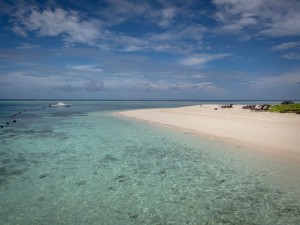 It takes one hour by boat to reach Sipadan Island. The island itself is very much what you would imagine a remote, tropical island to be – powder white sandy beach, turquoise waters, palm trees swaying ever so gently in the breeze. Simply stunning. After each dive, we had a break on the island, but we were restricted to one specific area, no exploring allowed.
It takes one hour by boat to reach Sipadan Island. The island itself is very much what you would imagine a remote, tropical island to be – powder white sandy beach, turquoise waters, palm trees swaying ever so gently in the breeze. Simply stunning. After each dive, we had a break on the island, but we were restricted to one specific area, no exploring allowed.
In spite of the poor visibility, the sea served up a vast array of strange and wonderful looking creatures and plants. There were lots of white tipped sharks, huge green and hawksbill turtles, and loads of other colourful fish we had never seen before. The corals were spectacular, not so much in their colours, but in their size and shapes.
For me the most amazing experience happened near the end of the second dive when we came across a massive school of Jackfish; there must have been thousands of them. As I casually swam along side them, they would shift their patterns to encircle me and before I knew it, I was in the middle of them, everywhere I looked there was a thick wall of Jackfish. Simply amazing. The most unusual fish we saw were the Bumphead parrotfish which is the largest species of parrotfish. These fish were big, about 4 feet long, and up to 100 pounds in weight. Their large, protruding teeth gave them a rather menacing appearance which kept me at a safe distance.
After our three dives at Sipadan, we were dropped off at Mabul Island, 20 km away, where we would spend the next two nights at our “resort”. This small island has been a fishing village since the 1970s, but more recently it has become popular to divers, mainly because of its proximity to Sipadan. Several resorts, ranging from bare bone to luxury, along with a large village of locals are all crammed onto this 20-hectare piece of land that sits just 2–3 meters above sea level.
 My heart sank as we climbed out of our boat onto the deck of our resort. I knew we had opted for budget accommodations, but this was really basic, and frankly, quite grim. Our resort was really nothing more than a long, rectangular wooden structure on stilts overhanging the water. At one end was three long tables with plastic patio chairs where we ate all our meals and hung out, and at the other end was the kitchen, shared bathroom and staff quarters. In between, about 10 small rooms lined both sides of the building. Each room had a window and was equipped with a bed, a table and a fan. This really did give us an opportunity to see what it was like to live as the locals live. It was okay for a couple of nights, but I wouldn’t have wanted to live here for a few months like the instructors do.
My heart sank as we climbed out of our boat onto the deck of our resort. I knew we had opted for budget accommodations, but this was really basic, and frankly, quite grim. Our resort was really nothing more than a long, rectangular wooden structure on stilts overhanging the water. At one end was three long tables with plastic patio chairs where we ate all our meals and hung out, and at the other end was the kitchen, shared bathroom and staff quarters. In between, about 10 small rooms lined both sides of the building. Each room had a window and was equipped with a bed, a table and a fan. This really did give us an opportunity to see what it was like to live as the locals live. It was okay for a couple of nights, but I wouldn’t have wanted to live here for a few months like the instructors do.
 Entrance to our resort from the island.
Entrance to our resort from the island.
 Inside view of the resort looking towards the kitchen.
Inside view of the resort looking towards the kitchen.
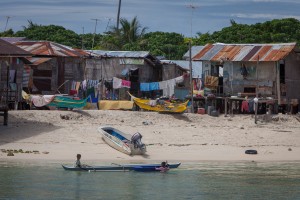 Island living: It was common to see young children, under five years of age,
Island living: It was common to see young children, under five years of age,
butt naked, paddling around in little dugout canoes. The sea was their playground.
 At over $1,000 p/p per night, these luxury bungalows
At over $1,000 p/p per night, these luxury bungalows
on the water were way out of our league.
What a sharp contrast to how the locals live.
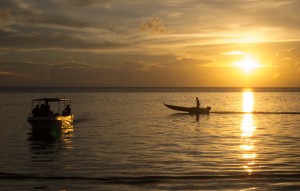 Beautiful sunsets were free for all to enjoy!
Beautiful sunsets were free for all to enjoy!
As we have discovered, it is often the people that make the experience and this place was no exception. We met the dive instructors – Ann and Gary, a couple originally from the UK, and Matt who was from Slovenia. All three had just arrived a few days earlier and were still getting oriented. Mohammed was the resident dive master who knew the outlying waters like the back of his hand. Alex was another instructor who was on his way out after doing a three month stint. There was only one other guest, Jenny, an older Asian woman from Spain. And of course, there was the staff who worked hard to keep the place spotlessly clean, and to prepare our meals and snacks.
 Our dives were varied, but most were shallow, less than 20 metres. I saw underwater wrecks for the first time as well as some man made reefs which are underwater structures that are made out of wood, rope, tires, and whatever else is available, and which over time become transformed into lovely reefs with lots of plants and fish. Most of this diving was macro, where we saw smaller things. Up until now, it was the big things that excited me, like sharks and turtles, but soon I was appreciating the smaller things too. The visibility was quite poor most of the time, around 10 metres, which made some of the wreck diving downright eerie.
Our dives were varied, but most were shallow, less than 20 metres. I saw underwater wrecks for the first time as well as some man made reefs which are underwater structures that are made out of wood, rope, tires, and whatever else is available, and which over time become transformed into lovely reefs with lots of plants and fish. Most of this diving was macro, where we saw smaller things. Up until now, it was the big things that excited me, like sharks and turtles, but soon I was appreciating the smaller things too. The visibility was quite poor most of the time, around 10 metres, which made some of the wreck diving downright eerie.
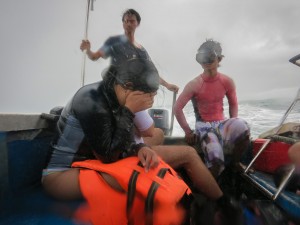 Each day it rained, often really hard, and usually when we were heading out for a dive which was rather miserable and not much fun at all. But it never lasted very long and soon the seas would calm down and the sun would be shining again. The rain cooled things off a bit which was quite welcome in the unbearable heat and humidity. We practically lived in our swim suits so it didn’t really matter if we got wet from the rain. I think the worst part of diving in the rainy season was the low visibility. Other than that, it was great.
Each day it rained, often really hard, and usually when we were heading out for a dive which was rather miserable and not much fun at all. But it never lasted very long and soon the seas would calm down and the sun would be shining again. The rain cooled things off a bit which was quite welcome in the unbearable heat and humidity. We practically lived in our swim suits so it didn’t really matter if we got wet from the rain. I think the worst part of diving in the rainy season was the low visibility. Other than that, it was great.
Video: Diving in Borneo
 We ended our diving excursion back on land with a final night at the Sipadan Inn where Denise was staying as well. Ann and Gary had a couple of days off, so they came back with us. As we were getting ourselves organized to go out for dinner in the hotel lobby, a man approached us to tell us about his menu that night. His makeshift kitchen was set up in front of a bar a couple of doors down. We had already decided to eat Indian food, but this guy was pretty convincing, and it didn’t take more than a taste of his home fries, to capture my vote. Besides, the bar where we would eat his dinner served beer and the Indian restaurant didn’t, so it was seafood for us that night, and what a feast we had. A couple of plates of complimentary sushi were served as starters, followed by a set menu that included the best grilled squid I have ever had, delectable scampi, and several fillets of fish, all nicely de-boned and grilled to perfection. It was a fitting end to a fun diving excursion.
We ended our diving excursion back on land with a final night at the Sipadan Inn where Denise was staying as well. Ann and Gary had a couple of days off, so they came back with us. As we were getting ourselves organized to go out for dinner in the hotel lobby, a man approached us to tell us about his menu that night. His makeshift kitchen was set up in front of a bar a couple of doors down. We had already decided to eat Indian food, but this guy was pretty convincing, and it didn’t take more than a taste of his home fries, to capture my vote. Besides, the bar where we would eat his dinner served beer and the Indian restaurant didn’t, so it was seafood for us that night, and what a feast we had. A couple of plates of complimentary sushi were served as starters, followed by a set menu that included the best grilled squid I have ever had, delectable scampi, and several fillets of fish, all nicely de-boned and grilled to perfection. It was a fitting end to a fun diving excursion.
 Before dinner, Denise (center) and Ann (right) were finishing up the final
Before dinner, Denise (center) and Ann (right) were finishing up the final
review of material for the Advanced course that Denise
successfully completed while on Mabul Island. Way to go Denise!
The next morning we were up bright and early to catch the 7:30 am bus to Sandakan where a jungle adventure awaited us.

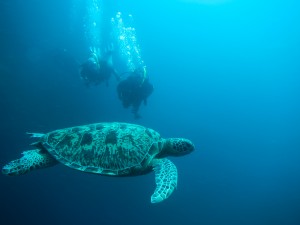




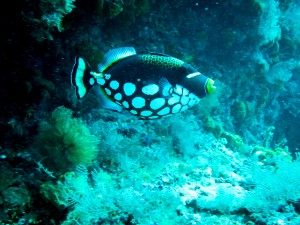
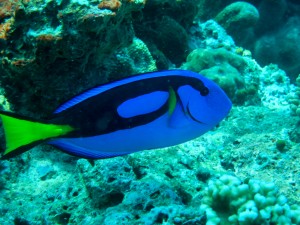




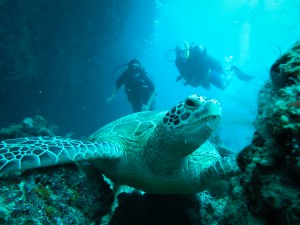
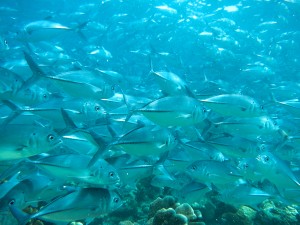

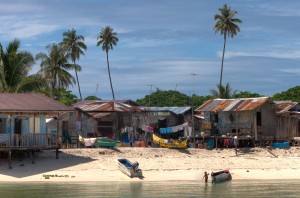




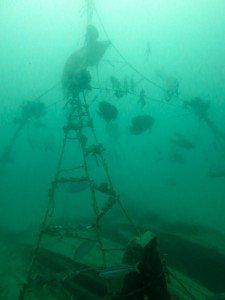

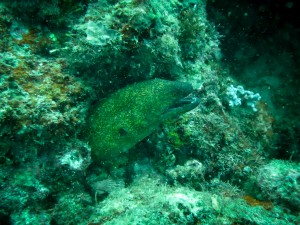
Hi Chrises
I don’t think my messages are getting through to you as i’ve not heard from you.I’ve been thinking a lot about you and have just seen your photos of all those beautiful fishes whilst you were under water swimming.I’m sure you are enjoying sight seeing Malaysia and islands of Indonesia and how the local folk live and you enjoying your creature comforts!
Lu and Sean,me too send our love and carry on enjoying all those wonderful cultural and exciting life experiences. Maureen xxx You lucky devils!
Hi Aunt Maureen,
Sorry I haven’t responded to your last email – I did indeed receive it but haven’t had time to respond to emails this past week. We’be been too busy diving and jungle trekking! Glad to see you’re still following our travels and I’m glad to hear you’re feeling well after your treatments. Say hi to Lulu and the family for us. Tell Columbus to check out our next blog entry – we’ll have lots of photos and video of really adorable monkeys, including a little baby long tailed Macaque that was just born, and the endangered orang utans!
Take care,
love
Christina
Congrats on landing in SE Asia!
If you at some time decide to turn north again, our daughter teaches in Jeju – island off the S of S Korea – has a small flat there. Kind of dreary in mid winter though. Very picturesque but also a bit out of the way!! You two write a tremendous story!
Hi Blair,
Thanks for the invite on behalf of your daughter. Right now we don’t have any plans to visit S Korea, but we never know from one day to the next where we might end up. We’ve just finished up our “jungle” tour where we saw the endangered orang utans in the wild as well as probiscus monkeys. We’ll write all about it in the next blog post. It was pretty incredible. Tomorrow we fly to Kuching which is still on the island of Borneo where we hope to do some more trekking.
Cheers.
Christina
Love to read your adventures!!!! It sounds all so amazing. I really like your writing. How is the book going on, I’m not sure if you still have time for this…since you are so busy.
Greetings from Dahab
Hi Emily,
Nice to hear from you. We have been so busy lately, I haven’t even touched my book since I left Dahab. I need to find another place just like yours so I can sit still for a while and write. Maybe when we get to Thailand we’ll slow down for a while.
Cheers,
Christina
Hi Guys, I think I’d be too afraid to swim with the sharks and eels. It must take some getting used to.